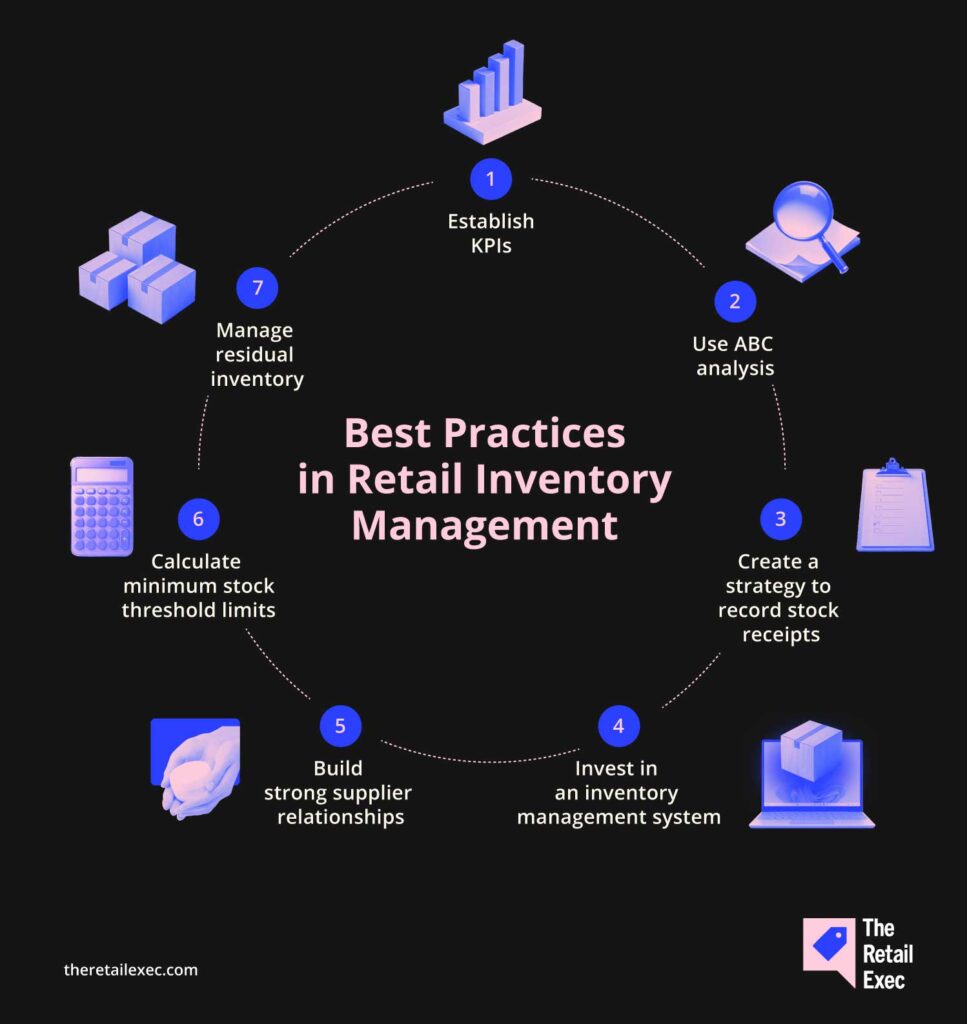Stockroom Symphony: Retail inventory management is chaotic and can lead to issues like excess unsold inventory or running out of bestsellers, negatively impacting cash flow.
Bestseller Balancing Act: Striking the right balance in inventory management is key to avoiding stockroom nightmares and ensuring healthy cash flow.
Chaos Tamed, At Last: Effective inventory management strategies can turn potential disasters into manageable situations, leading to more organized stock control.
From Trench Trials to Success: Real-world experiences in inventory management, even with large companies, highlight the critical need for effective systems and strategies.
Inventory Peace of Mind: With the right approach, retail inventory management doesn't have to be a source of stress and can contribute to business success.
Ever found yourself drowning in unsold inventory while somehow running out of your bestsellers at the worst possible time? Welcome to the chaos of retail inventory management—where one wrong move can turn your stockroom into a nightmare and your cash flow into a disaster.
But here’s the good news: it doesn’t have to be this way.
I’ve been in the trenches—as an inventory manager for a multinational homewares behemoth (yep, it was Crate & Barrel).
I’ve seen what happens when inventory gets out of control—it eats up cash, frustrates customers, and turns operations into a constant fire drill. But I’ve also seen how the right systems and strategies can transform a business, keeping stock levels tight, costs low, and customers happy.
This guide is your roadmap to inventory sanity—from the basics to the must-have systems and strategies that keep your stock in check (and your stress levels down).
Whether you’re running a storefront, an online shop, or juggling both, we’ll show you how to make inventory management work for you, not against you.
Let’s do this.
What is Retail Inventory Management?
Retail inventory management is the art of keeping just the right amount of stuff on your shelves—no more, no less.
Too little stock? You lose sales. Too much? You’re basically hoarding cash in the form of unsold products.
The goal is simple: always have what customers want, without drowning in excess inventory.
Why does this matter? Because inventory is money. Every unsold item sitting in your stockroom is cash that could be working elsewhere in your business. Smart inventory management means fewer stockouts, less deadstock, and more profit.
But it’s not just about guessing how much to order.
Today’s inventory management is high-tech. It involves real-time tracking, demand forecasting, and seamless coordination across stores, warehouses, and online platforms.
Thankfully, inventory management software can handle a lot of the heavy lifting, helping retailers stay organized without manually counting boxes every night.
Mastering this process means fewer headaches, happier customers, and a business that runs like a well-oiled machine. If you’re ready to get your inventory under control, let’s break it down.
Types of Retail Inventory You Must Manage

As a retailer, you have several inventory categories to track, each requiring different management strategies. Understanding these types helps you avoid waste, improve cash flow, and keep operations running smoothly.
Raw materials
These are the building blocks of your products—ingredients, fabrics, components, or any other materials used in manufacturing. If you produce your own goods, managing raw materials inventory is critical.
Order too little, and production halts. Order too much, and you’re stuck with excess materials collecting dust.
To manage raw materials effectively:
- Work with reliable suppliers to avoid delays.
- Keep an eye on quality—bad materials lead to bad products.
- Time your orders carefully to align with production schedules.
Work-in-progress (WIP) inventory
WIP inventory includes products that are partially completed but not ready for sale. Think of it as the halfway point between raw materials and finished goods.
For retailers who manufacture their own products, mismanaging WIP can lead to production bottlenecks and excess waste.
The key to controlling it is tight coordination between production, labor, and demand forecasting.
Finished goods
This is the inventory that actually makes you money. Finished goods are fully completed products, ready for sale and shipment.
To manage finished goods effectively:
- Optimize stock levels to meet demand without overstocking.
- Store inventory properly to prevent damage or obsolescence.
- Streamline distribution, so products reach customers fast.
Maintenance, repair & operations (MRO) goods
MRO goods aren’t for sale, but they keep your business running. This includes tools, cleaning supplies, spare parts, and anything else needed to maintain equipment and facilities.
Even though they’re not revenue-generating, running out of MRO supplies can bring operations to a grinding halt.
Keep them stocked—but don’t overdo it and waste money on excess.
Packing materials
Boxes, bags, tape, labels, and protective packaging—all the stuff that keeps your products safe and looking good during shipping.
Many retailers underestimate the importance of packing materials, but running out can cause major delays and unhappy customers.
Keep an eye on supply levels and reorder before you’re scrambling to find a roll of tape at the last minute.
Benefits of Proper Retail Inventory Management
From cutting costs to keeping customers happy, smart inventory management has a ripple effect that touches every part of your business. Get it wrong, and you could be losing money without even realizing it.
Inventory management is hard. It costs you money, time, and effort to manage your inventory well. But it costs you more to manage it badly.
Here’s why getting your retail inventory right is a game-changer:
Lower inventory costs
Knowing exactly what’s in stock and what’s needed means you’re not wasting money on excess inventory or paying for storage you don’t need.
When you optimize your inventory, you reduce carrying costs, free up cash flow, and avoid the dreaded markdown cycle that eats into your margins.
Instead of stockpiling products that may never sell, you can reinvest that capital into areas that drive growth—like marketing, customer experience, or expanding your product line.
Fewer stockouts & lost sales
Nothing kills a sale faster than telling a customer their must-have item is out of stock.
When inventory is properly managed, you’ll always have the right products available when and where they’re needed.
- Real-time tracking ensures stock levels are updated across all sales channels.
- Automated reordering helps you restock before products run out.
- Multi-location inventory transfers let you move stock to where it’s needed.
- Drop-shipping options allow you to fulfill orders even when you’re out of stock.
With these strategies in place, you won’t just avoid lost sales—you’ll turn potential inventory issues into customer service wins.
Stronger operational efficiency
Keeping track of inventory manually? That’s a one-way ticket to mistakes and wasted time.
Modern inventory management tools automate tracking, reduce human error, and sync inventory across all sales channels—whether it’s your physical store, ecommerce site, or a mix of both.
No more scrambling to figure out where a product is or accidentally overselling an item you don’t actually have in stock.
Less time fixing inventory mistakes means more time spent growing your business.
Happier customers and better reviews
Customers expect fast, reliable service.
When you have the right stock at the right time, you can fulfill orders quickly, avoid frustrating backorders, and provide accurate stock availability online and in-store.
- Faster fulfillment = happier customers.
- Fewer “out of stock” messages = more sales.
- Accurate online inventory listings = higher trust and fewer cancellations.
- Positive shopping experiences = better reviews and more repeat business.
Higher profit margins
Good inventory management is about more than having the right amount of stock—it also gives you the data to make smarter business decisions.
When you know which products sell best and which ones collect dust, you can:
- Fine-tune pricing to maximize profits without unnecessary markdowns.
- Time promotions strategically to move slow-moving inventory before it becomes dead stock.
- Stock bestsellers efficiently so you’re never missing out on revenue.
When you control your inventory, you protect your profits.
At the end of the day, inventory management isn’t just about your bottom line—it’s about keeping customers coming back.
Best Practices in Retail Inventory Management

Now that you understand the benefits of inventory management, let’s talk about how to actually do it right.
The goal isn’t just to track products—it’s to ensure your inventory system is driving profits, preventing waste, and helping your business scale. Here’s what the experts recommend:
Establish key performance indicators (KPIs)
If you’re not measuring performance, you’re just guessing. Key performance indicators (KPIs) provide real, actionable data about how well your inventory strategy is working—and where you might be bleeding cash.
Some of the most important KPIs to track include:
- Inventory turnover ratio: Measures how quickly inventory is sold and replaced, indicating stock efficiency.
- Gross margin return on investment (GMROI): Shows how much gross profit you generate for every dollar spent on inventory.
- Sell-through rate: Tells you how fast inventory is selling, helping you avoid dead stock and adjust purchasing decisions.
- Stock-to-sales ratio: Compares inventory levels to sales, revealing overstocking or understocking issues.
- Perfect order rate: Tracks the percentage of orders fulfilled accurately and on time, highlighting supply chain efficiency.
- Days on hand: Calculates the average time inventory sits before selling, helping optimize stock levels.
- Lead time: Measures how long it takes for inventory to arrive after ordering, crucial for demand planning.
- Inventory shrinkage: Shows the gap between recorded and actual inventory, flagging losses from theft, damage, or admin errors.
Why does this matter? Because if you’re not tracking these numbers, you might be overstocking, understocking, or wasting money without realizing it.
Modern inventory software can handle the heavy lifting—automating KPI tracking and giving you real-time insights into your inventory health. By monitoring these regularly, you’ll spot trends early, fix inefficiencies, and make smarter purchasing decisions.
Use ABC analysis

Not all inventory is created equal. ABC analysis helps you categorize your stock based on its value to your business, so you can focus your time, money, and effort where they matter most.
Here’s how it works:
- A-items: These are your high-value, low-quantity products—the ones that drive the bulk of your profits. They require close monitoring, frequent reordering, and careful stock control.
- B-items: These fall in the middle—moderate value, moderate sales. Important but not mission-critical, they need regular but not obsessive oversight.
- C-items: These are your low-value, high-quantity products—things like socks, t-shirts, or everyday basics. They sell steadily but contribute less to your bottom line. You can afford to keep larger stockpiles with less frequent reordering.
Think of it this way:
If you run a clothing store, your “A” items might be designer jeans and premium outerwear that generate 80% of your revenue but only take up 20% of your inventory.
Your “B” items could be mid-range accessories and casual wear, while “C” items are the budget-friendly essentials that move consistently but aren’t your big moneymakers.
Pro tip: If you are, in fact, a seller of clothing, it would behoove you to find inventory management software made for fashion brands. Check out our picks for apparel inventory management solutions.
By organizing inventory this way, you can prioritize what needs your attention most, avoid tying up cash in low-margin items, and streamline your inventory management for maximum profitability.
Nail your stock receipt process
If your stock receipts aren’t recorded properly, your inventory data is basically a guessing game.
Untracked stock leads to stockouts, overstocks, and accounting nightmares. To avoid the chaos, you need a clear, consistent process for recording every product that enters your business.
Here’s what a solid stock receipt strategy should include:
- Count all products against purchase orders. Don’t assume everything arrived as expected—verify quantities before accepting stock.
- Document any discrepancies or damages. Missing items? Damaged goods? Log the issues immediately to avoid surprise shortages later.
- Follow up with suppliers about errors. Mistakes happen, but if you don’t flag them, they won’t get fixed. Communicate discrepancies quickly to get credits, replacements, or refunds.
- Update inventory counts in your system immediately. Delayed updates lead to inaccurate stock levels and messy reporting. Enter new stock into your system as soon as it’s verified.
- Audit receipt records regularly. Even with a good process, mistakes can slip through. Regular audits help catch and correct errors before they cause bigger problems.
A structured stock receipt strategy keeps your inventory data accurate, prevents costly mistakes, and strengthens your supplier relationships.
Get it right, and you’ll spend less time fixing inventory errors and more time selling.
Invest in powerful inventory management software
Trying to manage inventory manually? That’s a fast track to wasted time, costly mistakes, and stock headaches.
Modern retail operations demand smarter, faster tools—and that’s where an inventory management system (IMS) comes in.
To maximize inventory and convert sales, retailers need to boost end-to-end visibility across multiple locations—from physical stores to warehouses.
Using an inventory management system (IMS) can empower businesses to take the guesswork out of this process by unlocking end-to-end visibility and automating smart stocking decisions.
An IMS is your control center for inventory. It helps you track, manage, and automate restocking so you’re never caught off guard by stockouts or drowning in excess inventory.
Instead of constantly scrambling to figure out what’s in stock and what needs ordering, an IMS gives you real-time insights and automation tools to keep inventory flowing smoothly. Learn more about the benefits of inventory management software.
Today’s inventory management systems offer powerful features like:
- Real-time inventory tracking. Know exactly what’s in stock across all locations at any moment.
- Automated reordering. Set reorder points and let the system handle replenishment for you.
- Multi-location management. Sync inventory across multiple stores, warehouses, and ecommerce channels.
- POS system integration. Connect inventory directly to sales for instant stock updates.
- Detailed reporting and analytics. Get data-driven insights to optimize purchasing and reduce waste.
- Supplier management tools. Streamline ordering, monitor vendor performance, and avoid supply chain disruptions.
The top tools for managing your inventory
With the right IMS in place, you’ll spend less time counting stock and more time making smart business decisions. It’s an investment that pays for itself in saved time, reduced errors, and improved cash flow.
Lucky for you, we’ve got big opinions about what inventory management software is worth the investment:
Your suppliers aren’t just companies you buy from—they’re essential partners in keeping your inventory stocked and your business running smoothly.
A strong supplier relationship can mean better pricing, priority treatment, more reliable deliveries, and faster issue resolution when things go wrong.
Here’s how to strengthen those relationships:
- Maintain open communication. Keep suppliers informed about changes in demand, potential issues, and upcoming needs.
- Share sales forecasts and trends. Giving suppliers insight into your projected demand helps them plan better, reducing delays and stock shortages.
- Pay invoices on time. Want better terms and priority service? Be the kind of customer suppliers want to work with.
- Provide feedback on product quality and service. Let suppliers know what’s working and where improvements are needed.
- Schedule regular review meetings. Check in periodically to discuss performance, new opportunities, and any potential challenges.
- Consider strategic partnerships for key products. Building deeper relationships with core suppliers can lead to exclusive deals, better reliability, and priority support.
At the end of the day, a strong supplier relationship benefits everyone—you get better inventory control, they get a reliable business partner, and your customers get the products they want, when they want them.
Stockouts again? There’s a better way. Check out these inventory replenishment apps before your customers check out for good.
Never get caught without stock
Running out of key products isn’t just frustrating—it costs you sales and customer trust. Setting minimum stock thresholds ensures you always have enough inventory on hand without overstocking and tying up cash.
Use this simple formula to calculate your minimum stock threshold:
Minimum stock threshold = (average daily product sales ÷ number of working days in a month) × average product delivery time
This calculation helps you:
- Keep enough stock to meet customer demand.
- Account for supplier lead times.
- Adapt to fluctuations in sales patterns.
By regularly reviewing and adjusting your threshold levels, you can prevent stockouts, avoid excess inventory, and keep your supply chain running smoothly.
Stores aren’t warehouses. Multi-echelon inventory makes sure they don’t get treated like one.
Make your excess inventory work for you
Residual inventory—especially seasonal or trend-based products—can quietly eat up storage space, tie up capital, and erode your margins if you’re not proactive.
Whether it’s last season’s fashion, holiday decorations, or other time-sensitive merchandise, managing excess stock is key to keeping your inventory lean and profitable.
Over the past 36 months, I’ve met with over 100 companies with demand planning and inventory optimisation being the main topic of conversation.
Safety stocks end up being reviewed every six months or annually. This is one of the main reasons why there are large volumes of inventory that do not turn.
So how do you keep excess inventory from piling up?
- Create clear season codes in your inventory system. This helps you track seasonal stock separately and move it before it loses value.
- Plan markdown strategies before the season ends. Waiting too long to discount seasonal items means they could become unsellable.
- Analyze historical inventory data. Look at past sales trends to fine-tune future purchasing decisions and avoid overbuying.
- Consider alternative sales channels. Sell excess inventory through outlets, online marketplaces, or even wholesale to other retailers.
- Develop relationships with liquidation partners. Having a go-to liquidator can help you quickly offload stagnant stock without a total loss.
- Bundle slow-moving items. Pair them with bestsellers to move them faster without steep discounts.
Managing residual inventory is more than merely clearing space—it’s about protecting your cash flow and keeping your stock dynamic. The faster you act, the less money you leave sitting in unsold products.
Retail Inventory Management Techniques That Work
Now that we’ve covered best practices, let’s dive into specific techniques that help fine-tune your inventory management. Whether you’re looking to cut costs, reduce waste, or improve cash flow, these methods can make a major impact.
Economic order quantity (EOQ)
EOQ helps you determine the optimal order size that minimizes total inventory costs by balancing ordering costs, holding costs, and demand.
Instead of ordering too frequently (increasing costs) or ordering too much at once (tying up cash in excess stock), EOQ finds the sweet spot.
EOQ formula:
EOQ = √[(2 × D × S) / H]
Where:
- D = Annual demand (units per year)
- S = Ordering cost per order
- H = Holding cost per unit per year
Using EOQ helps reduce over-ordering, lower storage costs, and improve cash flow. However, it assumes steady demand, so it works best for businesses with predictable sales patterns.
Just-in-time (JIT) inventory
JIT is all about timing stock arrivals perfectly—you receive inventory right before you need it, reducing storage costs and waste.
This technique works best when you have accurate demand forecasting and reliable suppliers who can deliver quickly.
While JIT can dramatically improve cash flow, it’s risky if supply chain disruptions occur. A late shipment could lead to stockouts, frustrated customers, and lost sales.
That’s why it’s best used with strong backup suppliers and contingency plans.
JIT works great—until it doesn’t. That’s when VMI steps up.
Safety stock and par levels
Safety stock acts as a buffer against unexpected demand spikes or supplier delays, ensuring you don’t run out of critical products.
Par level, on the other hand, is the minimum amount of stock you should always have on hand before reordering.
Safety stock formula:
Safety stock = (Max daily usage × Max lead time) - (Avg daily usage × Avg lead time)
By setting the right safety stock and par levels, you can reduce the risk of stockouts without tying up excess capital in inventory.
Reorder point
The reorder point is the inventory level at which you should trigger a new order before running out of stock.
Reorder point formula:
Reorder point = (Average daily sales × Lead time) + Safety stock
Getting this right ensures you restock at the perfect time—before you run out but without over-ordering.
Dropshipping
Dropshipping allows you to sell products without ever holding inventory. Instead, your supplier ships items directly to the customer.
Pros:
- No storage costs or warehouse management.
- Low upfront investment.
- Ability to test new products with minimal risk.
Cons:
- Less control over shipping times and quality.
- Lower profit margins than traditional inventory models.
- Higher dependency on third-party suppliers.
Dropshipping is best for expanding product offerings or testing demand without committing to bulk stock.
Each of these methods has its strengths and weaknesses. Your best bet? Use a mix.
For example, JIT might work well for fast-moving items, while safety stock protects against supplier delays. EOQ can optimize bulk ordering, and dropshipping can test new products before committing to stock.
Retail Inventory Management Challenges (And How to Fix Them)
Even with the best practices and techniques in place, inventory management isn’t always smooth sailing.
Between 10% to 40% of the ~100bn garments made every year don’t get sold. And they’re piling up in landfill.
For brands, over stocking is a commercial dilemma. For the environment, it’s a looming disaster.
Overstocking is a major challenge, but it’s far from the only issue retailers face. Here’s a look at some of the biggest hurdles—and how to overcome them.
Stockouts and overstocks
Finding the perfect balance between too much and too little inventory is one of the hardest parts of retail.
Stockouts lead to lost sales and unhappy customers, while overstocks tie up cash and rack up storage costs.
Fix it:
Use demand planning software and analyze historical sales data to make smarter purchasing decisions. Real-time inventory tracking also helps identify trends and adjust stock levels before problems arise.
Inventory shrinkage
Shrinkage—caused by theft, damage, or administrative errors—eats into your profits and skews inventory data. Retailers lose billions annually due to preventable inventory losses.
Fix it:
Invest in RFID tags, item tracking software, and security cameras to monitor inventory movements. Regular audits and staff training can also reduce errors and deter theft.
Multichannel complexity
Selling in-store, online, and on marketplaces (like Amazon or eBay) can turn inventory management into a logistical nightmare.
Stock discrepancies across platforms lead to overselling, stockouts, and frustrated customers.
Fix it:
Use an inventory management system that syncs stock levels in real time across all sales channels. This integration prevents overselling, improves order fulfillment, and streamlines operations.
Seasonal demand fluctuations
Retail demand isn’t constant—holiday shopping spikes, back-to-school rushes, and slow seasons all impact stock needs.
Poor forecasting can leave you scrambling to meet demand or stuck with excess inventory.
Fix it:
Analyze past sales trends and use forecasting models to adjust inventory levels ahead of peak seasons. Pre-booking stock and allocating resources accordingly helps ensure you’re stocked up at the right times.
Supply chain disruptions
Global events, natural disasters, or shipping delays can throw your entire inventory plan off track. If your supplier is delayed, you risk running out of key products and disappointing customers.
Fix it:
Diversify your supplier base so you’re not overly reliant on one source.
Keeping safety stock for high-demand items and regularly reviewing logistics strategies can improve resilience to disruptions.
No inventory system is perfect, but proactive planning, strong technology, and smart forecasting can help retailers avoid these common pitfalls.
Master Your Inventory, Master Your Business
Retail inventory management can feel like a never-ending balancing act.
Too much stock? You’re burning cash. Too little? You’re losing sales. But with the right strategies, it doesn’t have to be a guessing game.
By tracking key KPIs, setting smart reorder points, and using inventory management systems, you can stay ahead of demand, reduce waste, and free up capital.
Techniques like EOQ, JIT, and safety stock planning help you fine-tune your inventory so you’re always stocked with what customers want—without tying up cash in what they don’t.
Strong supplier relationships, real-time tracking, and a data-driven approach will help you navigate the challenges of multichannel sales, seasonal demand shifts, and supply chain disruptions.
The businesses that stay on top of inventory don’t just survive—they scale, adapt, and grow.
Now’s the time to ditch the stockroom stress and start managing inventory with confidence.
Retail never stands still—and neither should you. Subscribe to our newsletter for the latest insights, strategies, and career resources from top retail leaders shaping the industry.




